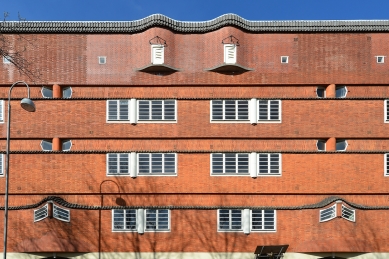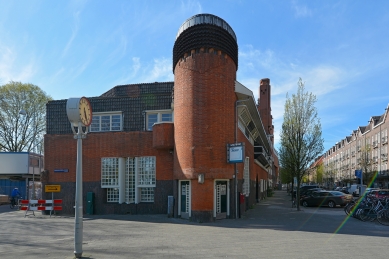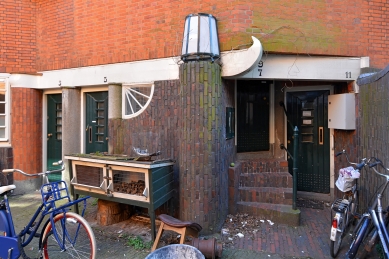
The Ship
Woningbouw Eigen Haard

The Ship (Het Schip) is an apartment building in the Spaarndammerbuurt district of Amsterdam, built in the architectural style of the Amsterdam School of Expressionist architecture. It is the single most important example of this style of architecture, using the Brick Expressionism version.
The building was designed by Michel de Klerk. The building vaguely resembles the outlines of a ship. Its appearance is very unconventional from all angles. Designed in 1919, the building contains 102 homes for the working class, a small meeting hall and a post office, which as of 2001 is the museum of the Amsterdam School.
In the 19th and early 20th century, Amsterdam faced a major housing shortage, with many working-class people living in cramped quarters with no electricity or running water. Heating was usually provided by burning peat, and poor families often lived in a single room together.
In response to these squalid conditions, the Dutch government passed the National Housing Act (Woningwet) in 1901. This law set up much higher standards for housing and resulted in both the demolition of older, inadequate tenement buildings and the creation of new housing blocks with much better living conditions and prices that made them accessible to Amsterdam's poorer citizens. The new law also set aside financial resources for the development of low-income housing. One of the affordable housing developments created in the wake of the passage of the National Housing Act was the Spaarndammerbuurt, where Het Schip and several other Amsterdam School social housing projects are located.
Much of the new low-income housing was financed by cooperative housing associations run by groups such as workers' collectives, socialist organizations, religious groups. One such group was Eigen Haard, or »our own hearth,« a socialist group that commissioned Michel de Klerk to design and build three blocks of proletarian housing, including Het Schip.
The apartments of Het Schip were a radical departure from the poor living conditions of many of Amsterdam's working-class people in the 20th century. Relatively spacious, they include several separate rooms as opposed to the one-room dwellings still common at the time. They also included flush toilets and had ample natural light and ventilation from windows. Ground-floor apartments also had gardens.
The building also includes a post office, which the poor had previously had little access to. The post office contained a telephone box from which families could make calls.
The building was designed by Michel de Klerk. The building vaguely resembles the outlines of a ship. Its appearance is very unconventional from all angles. Designed in 1919, the building contains 102 homes for the working class, a small meeting hall and a post office, which as of 2001 is the museum of the Amsterdam School.
In the 19th and early 20th century, Amsterdam faced a major housing shortage, with many working-class people living in cramped quarters with no electricity or running water. Heating was usually provided by burning peat, and poor families often lived in a single room together.
In response to these squalid conditions, the Dutch government passed the National Housing Act (Woningwet) in 1901. This law set up much higher standards for housing and resulted in both the demolition of older, inadequate tenement buildings and the creation of new housing blocks with much better living conditions and prices that made them accessible to Amsterdam's poorer citizens. The new law also set aside financial resources for the development of low-income housing. One of the affordable housing developments created in the wake of the passage of the National Housing Act was the Spaarndammerbuurt, where Het Schip and several other Amsterdam School social housing projects are located.
Much of the new low-income housing was financed by cooperative housing associations run by groups such as workers' collectives, socialist organizations, religious groups. One such group was Eigen Haard, or »our own hearth,« a socialist group that commissioned Michel de Klerk to design and build three blocks of proletarian housing, including Het Schip.
The apartments of Het Schip were a radical departure from the poor living conditions of many of Amsterdam's working-class people in the 20th century. Relatively spacious, they include several separate rooms as opposed to the one-room dwellings still common at the time. They also included flush toilets and had ample natural light and ventilation from windows. Ground-floor apartments also had gardens.
The building also includes a post office, which the poor had previously had little access to. The post office contained a telephone box from which families could make calls.
1 comment
add comment
Subject
Author
Date
Díky!
Vích
15.08.20 06:50
show all comments





























